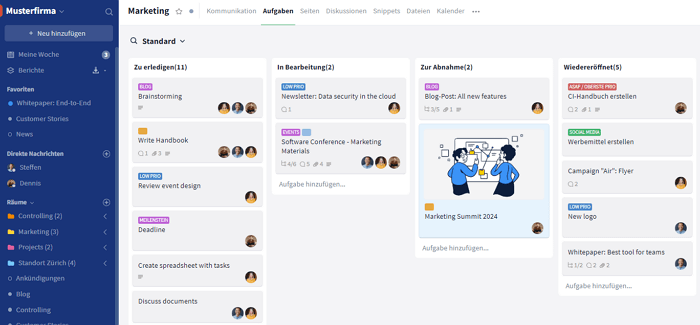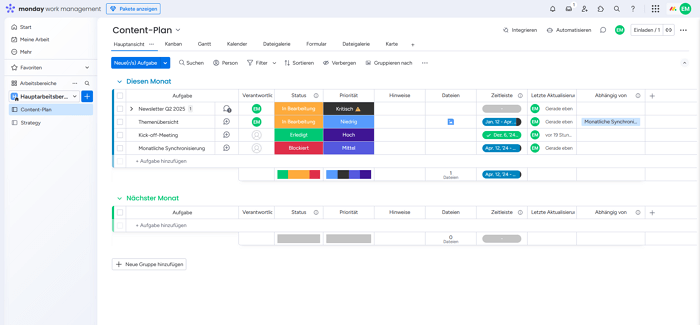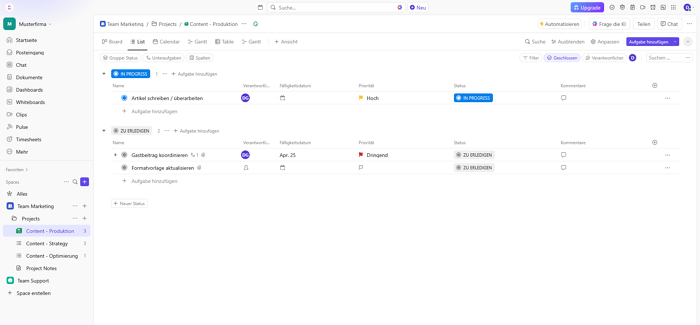Teamwork increasingly means hybrid collaboration: Team members work in the office, (on a daily basis) in the home office or completely remotely. So much flexibility is possible thanks to collaboration tools. They bring teams into (almost) as close contact and exchange digitally as they do on site. In this way, collaboration can be organized effectively regardless of physical distance and time. In this article, you can read about the functions collaboration tools offer and the advantages and disadvantages of collaborative software. We also give you comparison of three popular tools.
Collaboration tools: definition
Collaboration tools support and organize digital team collaboration. This benefits both on-site teams and teams working together on projects at different locations. Most tools can be used as a web version or app on all end devices so that you have access to this shared workspace at any time and at any workstation.
Collaboration tools ensure
uncomplicated communication between team members and help with the planning, coordination and execution of projects and the associated tasks. They also enable the joint editing of documents and therefore serve as a complete database for the respective project.
What functions do collaboration tools have?
Collaboration tools have various functions so that they can meet the different requirements of teams. So before introducing collaborative software, you should consider which features your team needs.
The most common functions of collaboration tools include:
- Communication channels (chats, text and voice messages, video conferencing, comments)
- Online management of projects, tasks and roles
- Option for uploading, saving, sharing and collaborative editing of documents
- Notifications about activities and events
- Visualization of project processes
The more functions, the better?
Good features are important. However, if a tool contains too many functions that your team doesn't need at all, a confusing user interface can also be detrimental to effectiveness. With Stackfield, you therefore only put the functions in the workspace that your team actually uses.
Overview of the different types
Many collaboration tools have a clear focus when it comes to functions. Several types can therefore be distinguished:
- Project management tools for task planning (e.g. Monday.com, Trello)
- Communication tools (e.g. Slack, Zoom)
- Document management (e.g. Dropbox, Google Drive)
- Collaborative editing of documents (e.g. OneNote, Google Drive)
- Collection of ideas / whiteboards (e.g. Miro)
Or would you prefer an all-in-one tool?
If your team needs several types of collaboration tools, you can of course combine individual solutions or use integrations. However, the interfaces usually remain somewhat bumpy, so that the workflow suffers and the individual tools, which are powerful in themselves, unfortunately do not provide the desired increase in effectiveness.
So, if your team needs several functions, an
all-in-one solution with a consistent user interface for all features is the better solution!
Advantages and disadvantages of collaboration tools
Good collaboration tools make teamwork much easier in many areas and significantly increase productivity - thanks to these advantages, among others:
- More transparency around task distribution and responsibilities
- Central storage of all important documents instead of chaos in mailboxes
- Faster progress thanks to real-time collaboration
- Project-related communication for more clarity
- Involvement of external partners
- Uncomplicated availability of all information anywhere and at any time
- Remote working option provides access to the global talent pool
These benefits of collaboration tools may be offset by some disadvantages:
- Inadequate data protection: Many collaboration tools are hosted in the USA. However, data-sensitive industries require tools such as Stackfield that meet the highest security and data protection requirements.
- Limited support: Many providers are only available to a limited extent for technical problems or questions or only offer English-language support.
- Too much information flow: Of course, communication channels must be used with a sense of proportion. Otherwise, too much exchange of (unimportant) information can cost a lot of time, take the focus away from the essentials and reduce productivity.
3 popular collaboration tools at a glance
There are now so many collaboration tools on the market that it's easy to lose track. Which software has which functions and supports your team in which area? For a little more clarity, we will briefly introduce you to three popular products with their individual features.
The all-in-one solution Stackfield

Stackfield combines all the important functions of collaboration tools in one software. Team chats and video conferences, task and project management, calendars, whiteboards and document management are all on one platform for highly effective collaboration. Therefor companies only have to purchase ONE collaboration tool for all applications with Stackfield. Simple rights management and billing are only some of the advantages.
The German provider Stackfield is also GDPR-compliant and guarantees that data is only transferred within the EU, with the servers themselves located in Germany. The data is therefore protected from access by third parties. Thanks to end-to-end encryption, not even Stackfield can view the data. The highest security standards, as required by authorities, law firms, pharmaceutical companies and churches, are thus met - as confirmed by ISO certifications 27001, 27017 and 27018.
The project management tool Monday.com

This cloud-based collaboration tool supports your team in planning, organizing and managing projects and to-dos. You can create boards on the user interface, set deadlines and assign tasks to people or groups. Communication takes place via chat. Documents can be shared and saved in Monday.com. If further tools are required for effective teamwork, it is necessary to integrate other software solutions.
Project and task management with ClickUp

The functional scope of the ClickUp project management tool is similar to that of Monday.com. There is also an area for creating and managing tasks. There you can track the progress of the project and change the status while working on it. A chat function is available for team members to exchange information on the various projects. The tool also includes document management and time recording. Other collaboration tools must be integrated if required.
How to find the right collaboration tool for your company?
Have you had enough of paperwork, missed deadlines and mixed mail accounts? Instead, would you like to make collaboration in your team clearer, more effective and more productive? In addition to the three solutions presented here, there are many more collaboration tools with different focuses and functionalities. To ensure that you ultimately choose the best software for your team, you should think about these questions in advance:
- What should the collaboration tool primarily do? Should it facilitate communication? Or does your team need help with project and task management?
- Are there mainly small teams in your company or do many colleagues work together on an interdisciplinary basis? Should external parties also be involved?
- How much storage space is required for document storage?
- Should several members of your team be able to work on a document at the same time?
- Is the chat function sufficient or should audio messages and video conferencing also be possible for a comprehensive exchange?
If you use this checklist to determine that your team needs collaborative software with only one or a few of the possible functions, a single solution may make sense. However, if your needs are more diverse, using several tools in parallel can quickly become ineffective and confusing. In this case, an all-in-one solution usually not only makes it easier for team members to familiarize themselves with the system, but also ensures a harmonious workflow.
Regardless of the scope of requirements, there is of course always the question of data protection. It's worth taking a closer look. Across all types of collaboration tools, the selection of truly data protection-compliant products is quite limited.
Almost finished...Please click the link in the email and confirm your email adress to complete the subscription process.
Never miss a post. Get awesome insights in your inbox.